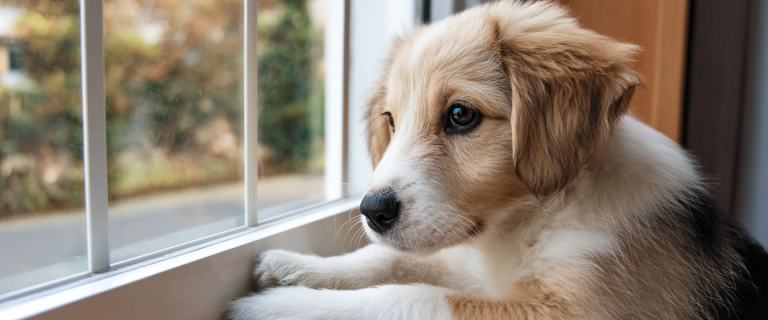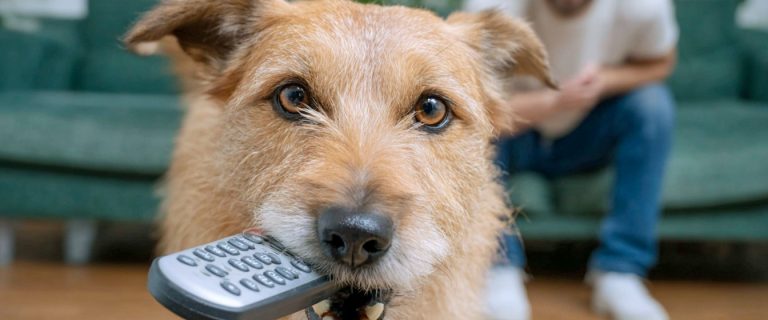If you’re wondering how to train a dog to use buttons for communication, you aren’t alone. Communication buttons have become a more popular topic among dog owners. But many have trouble understanding what these devices do or how to use them properly. It’s why I thought providing a clear guide about these valuable tools was crucial. So read on, and you’ll soon know everything about them and how to train a dog to use them effectively.

What Are Communication Buttons for Dogs?
In a nutshell, dog communication buttons will help your pup understand human language. They will have words on them that your dog will associate with specific actions. Your dog will then press them to communicate what they want from you. Therefore, using these buttons helps owners recognize what their pup wants.
But this communication only occurs when your dog’s trained to use them properly. Due to this, it’s essential to go through the training process with a positive and patient attitude. If not, the exercise won’t be rewarding or successful.
Check out the video below for a closer look at what you can do with dog communication buttons:
Benefits of Using Dog Communication Buttons
Since we’ve covered the basics of communication buttons, it’s time to consider their benefits. It’s the only way to ensure training your dog to use them is a worthwhile step. Otherwise, you won’t have a solid idea of what a successful training experience will offer.
Allows Dogs to Communicate Needs
Dog communication buttons provide your dog with a voice to communicate its needs. These tools allow them to tell their owners when they want to sleep, walk, eat, and much more. It’s just a simple matter of making them associate a specific button with those particular needs.
Once trained, your dog will stand on these buttons to let you know what they want. It’s a cute and convenient trick to help owners understand their dogs better. You won’t have as many instances of asking yourself, “what in the world does my dog want?”
Improves Your Dog’s Learning and Training Abilities
Teaching dogs to use buttons can improve their learning and training abilities. Basically, it makes them more suitable for learning new skills. You can also incorporate these tools into other training sessions to help limit how much work is necessary.
Honestly, these buttons have done wonders for helping my Pitbull learn new commands. I thought she was too old to learn new ones, but these tools have helped us break new ground. It’s easy to see how it could help almost any dog owner have similar results.
Bonding
Any good training session will bring an owner and their dog close together. Teaching your dog how to use communication buttons isn’t any different. It’ll represent an excellent way to further your bond while providing them with valuable and convenient training.
Limits Whining and Barking
Pet owners constantly look for ways to limit their dog’s barking and whining. These buttons represent a potential way of reducing those annoying habits. After all, your dog can use them to indicate their demands rather than barking off their heads.
But some dogs are stubborn and love barking. For instance, my Beagle mix got through all his button training with flying colors. He now sits on the buttons to communicate while barking simultaneously.
How to Train a Dog to Use Buttons for Communication
Training a dog to use button communication isn’t too tricky. In fact, I’ve nailed the process down into an easy-to-follow guide with only five steps. It shouldn’t have issues helping ensure these training sessions are hassle-free and smooth.
1. Make a Supply Run
Your first step is to ensure you have all the necessary supplies. It may seem like common sense, but many dog owners start this process without any preparation. It ends up being a mistake that negatively impacts the training. Here’s a quick list of what you’ll need to gather before moving on to step 2:
- Dog communication buttons
- Treats
- Food bowl
- Your dog’s favorite toys
- Any other props you’ll link to a communication button (crates, leashes, etc.)
2. Regularly Communicate with Your Dog
Pet owners often make the mistake of confusing their dogs by mixing up phrases. For instance, they could use two different words, “eat” and “dinner,” when indicating it’s time to eat. You’ll want to avoid doing this entirely and start using a single word for each association.
So if you choose to use “eat,” say it every time it’s time for dinner. This repetition will help form an association in your dog’s brain much quicker. You’ll also want to acknowledge your dog’s response to the chosen work with positive reinforcement. For example, some owners reinforce it with an extra pet or by adding the word “good” onto the command.
Check out the video below to learn more about positive reinforcement training:
3. Locate and Setup the Buttons
Once your dog’s comfortable, set up a button or two when talking to them. I’d recommend letting them sniff the buttons beforehand to ensure they don’t get scared. My Pitbull is a little skittish about new objects, so it took a while for her to get comfortable with them.
After introducing the buttons, say your chosen words and press them repetitively whenever your dog follows the command. You’ll soon notice them associating the activity and your communication buttons.
But I must warn you that dogs learn at different speeds. Some pups will start making these associations within a few days, while others, like my Pitbull, can take almost a month. Please remain patient and repeat your button pressing consistently.
4. Let Your Dog Take Over The Button Pressing
The next step will be a little more involved. After all, it’s time to teach your dog how to press these buttons. Some pups will take it upon themselves and push the button without assistance. It’s something that they’ll learn by watching you press it regularly.
Meanwhile, others won’t take to the button pressing as quickly. These dogs may stand by these buttons and whine/bark to get your attention. Therefore, it becomes necessary for you to help make the association thoroughly ingrained in your dog’s brain.
My preferred method is to teach them how to ‘paw” the button. Basically, you take the communication button in your hand and press their paws on it. Take some time and make sure your dog understands the association.
Once they do, move the button to the ground and signal to press it by pointing at it. Give your dog some treats and shower praise on them whenever they press the button. You’ll start to notice the association taking hold more and more with time/praise.
5. Enjoy The Benefits
Your dog should now thoroughly understand how to use these buttons. They’ll have no issues communicating their needs and developing a deeper bond with you. You’ll soon reap all the benefits of using these excellent products.
In Closing,
Training a dog to use buttons for communication is about building associations between certain activities and these tools. You can achieve these associations by using positive reinforcement techniques and showering your dog with praise.
Have you tried to train your dog to communicate using buttons? Share your experiences below!
Author
-

My name is Ben Roberts, and I’ve been writing about animals for many years. Honestly, I couldn’t ask for a much better job, considering I’ve been around animals all my life. I can’t remember a time when there wasn’t at least one cat or dog inside my home. Currently, I’m a proud owner of a Beagle and a Pitbull who make sure my life is never dull.
View all posts


